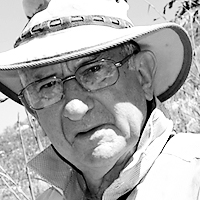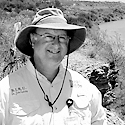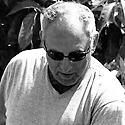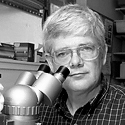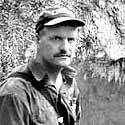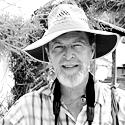Sunday, October 3
3:00-6:30 PM Registration
6:30-9:30 PM Mixer and wine tasting (following custom of similar meetings, we request that participants bring one bottle of their favorite local wine)
Monday, October 4
7:45 AM-8:00 AM
Welcome: Dean Steven Goodwin, University of Massachusetts, College of Natural Sciences
8:00-8:45 AM
Plenary Address by Dr. Cliff Moran, J.H. Hoffmann and M.P Hill. Cliff Moran’s research interests were shaped in the late 1960s by the supportive interventions of some of the recognized leaders of modern biological control - Dick Doutt, Ken Hagen and Carl Huffaker at the University of California, Berkeley. His specific focus on the biological control of weeds was developed under the mentorship of David Annecke in South Africa. Cliff was a Professor of Entomology and, for a short period, Dean of Science at Rhodes University in Grahamstown, then from 1986 – 1998 was the permanent Dean of Science, and a member of the University Council, at the University of Cape Town (UCT). He has spent formative periods at Cornell University, Imperial College at Silwood Park, Oxford, and at the University of Arizona. He is currently active in field-based research, through the Biological Control Research Unit, headed by John Hoffmann, at UCT, and is involved in policy matters in respect to the biological control of alien invasive plants in South Africa, with significant involvements in South Africa’s Working for Water Programme and with the South African National Biodiversity Institute. He has published over 100 research publications, mostly on the biological control of weeds using plant-feeding insects.
Preserving the Fynbos. Cliff Moran will elaborate on some recent and current successes in biological control of invasive plants in riparian and conservation areas in South Africa. The main problems addressed will include the greatly reduced water supplies caused by introduced acacias, hakeas, gums, and pine that escape from forestry areas and grow elsewhere. These trees intercept the run-off in catchments and extract the water directly from the rivers. Large infestations of these trees are responsible for many species extinctions in the Cape Floral Kingdom, which is one of the most diverse plant-biomes in the world. These trees are also responsible for more frequent and hotter fires that degrade and erode the soil. Biological control of many of these species, using plant feeding insects, and some pathogen species, has been successful and is now a proven and highly cost-effective supplement to chemical and mechanical management of these invasive plants. The wide economic and political dimensions of these projects, including their importance for protection of future water supplies, biodiversity, and ecosystem services in South Africa will be discussed.
I. Placing Biological Control in Ecological Context
8:45- 10:55 AM
Symposium 1. Integrated ecosystem management: how important are invasive plants and biological control in natural areas, Organizer: Bernd Blossey (Cornell University)
Overview of talks. This symposium will critically examine causes of ecosystem change, the role invasive species may play as drivers of this change, and how biological control may contribute to better land stewardship. This will include a comparison of differences in ecosystem impacts between native and introduced species, an examination of the evidence and justification for engaging in invasive plant control using case studies, and an assessment of the ability of biological control to achieve overall management goals. Biological control can only be successful in achieving ecosystem benefits if the targets of biocontrol efforts are indeed the major stressors and not just symptoms of other native or introduced stressors (ungulate herbivory, earthworm or other invertebrate invasions, nutrient loading, etc.). Furthermore, biological control may achieve biological successes (control of the target invader) but not the desired ecological benefits to species and ecosystems if one invader is being replaced by yet another invasive species. A paradigm shift from what we are managing against to clearly articulating and measuring what we are managing for is required to protect natural ecosystems and maintain biological control as a management tool.
8:45-8:50 Introduction: Bernd Blossey
8:50-9:10. Tom Dudley and Dan Bean. Tamarix biocontrol and an endangered bird: can ecosystem restoration provide a path through regulatory dysfunction? University of California, Santa Barbara
9:10-9:35. Rieks van Klinken. "Picking the right fight: how target selection can determine success and failure of biocontrol " CSIRO, Indooroopilly,Queensland, Australia
9:35-9:55. John Hoffmann, Fiona Impson, Carien Kleinjan and Cliff Moran. Biological control of Australian acacias in South Africa: limitations and expectations. University of Cape Town
9:55-10:15. Dick Shaw. The plant that ate the shopping mall - Japanese knotweed tests attitudes to invasives and biocontrol in Europe. CABI Europe, UK
10:15-10:35. Laura Martin and Jill Cohen, John Maerz, Victoria Nuzzo. and Bernd Blossey. Quantity counts, origin does not: a tale of traits and ecosystem impacts. Cornell University
10:35-10:55. Bernd Blossey. Quo vadis biological control? Cornell University
10:55-11:10 AM Coffee and refreshments
11:10-12:50 PM
Symposium 2. Ecological Ramifications of Biological Control of Fire-connected Invasive Species, John Goolsby, USDA-ARS, Texas, organizer.
Overview of talks. Introduced plants such as grasses, saltcedar, Old World climbing fern, and melaleuca, have altered fire regimes in native ecosystems. Biological control of some of these species has potential to return invaded communities to near historical fire regimes. Some groups such as grasses that formerly were not considered possible targets for biological control are being reconsidered. New strategies such as host specific detritivores to reduce fuel load will be discussed.
Speakers
11:15-11:35. Quentin Paynter & Grant J. Flanagan Integrating herbicide and mechanical control treatments with fire and biological control to manage an invasive wetland shrub, Mimosa pigra. Manaaki Whenua Landcare Research, Auckland, New Zealand.
11:35-11:55 Alex Racelis. Restoration of riparian ecosystems in the Southwestern U.S., through biological control of the pyrogenic invader Arundo donax. USDA-ARS, Beneficial Insects Research Unit, Weslaco, TX, USA.
11:55-12:15. Don Sands The case for biological control of the exotic African grasses in the Australia and the USA using introduced detritivores. CSIRO Entomology, Indooroopilly, QLD, Australia.
12:15-12:35. John Goolsby. Potential for biological control of African Guineagrass. USDA-ARS, Beneficial Insects Research Unit, Weslaco, TX, USA.
12:50-1:50 PM Catered lunch on site (included in registration)
2:00-3:20 PM
Symposium 3. Nutrient Loading and Biological Control of Aquatic Plants---What are the Interactions? Michael Grodowitz, US Army Engineers Research and Development Center, Vicksburg, MS, organizer.
Overview of talks. Little information is available on the role of nutrients and their impact on the functioning and efficacy of biological control agents. This is especially true in the aquatic environment. In this regard, this session will first examine the role nutrients play in the aquatic environment and how they ultimately impact aquatic plant biology, phenology, growth and reproduction. We will then examine the effects nutrients have on biocontrol agent biology and efficacy, both directly and indirectly. Lastly we will discuss the importance of approaching aquatic plant management holistically, integrating biomass reduction methods (i.e., chemical or mechanical technologies) with the manipulation of the important underlying factors that allow the development of dense plant populations, such as a lack of host-specific herbivores to suppress growth and reproduction, and reduction of available nutrients through the fostering of a robust and diverse native plant community that can act as a nutrient sink.
Speakers
2:00-2:20. Robert Doyle. Nutrients in the aquatic environment: Impact to aquatic plants Department of Biology. Baylor University, Waco, TX
2:20-2:40. Judy Shearer. Nutritional characteristics of Hydrilla verticillata and its affect on two biological control agents. US Army Engineer Research and Development Center, Vicksburg, MS
2:40-3:00. Julie Coetzee and Martin Hill. The role of eutrophication in the biological control of water hyacinth in South Africa - evidence from the laboratory and the field. Dept. of Zoology and Entomology, Rhodes University, Grahamstown, South Africa
3:00-3:20. Michael Smart. An ecological approach to aquatic plant management. Lewisville Aquatic Ecosystem Research Facility, Lewisville, TX
3:30-3:20 PM Coffee and refreshments
II. Islands, Ants, Forests, and Pathogens
3:40-5:40 PM
Symposium 4. Biological control for invasive species management on islands. Simon Fowler, Landcare, New Zealand, and Charlotte Causton, Charles Darwin Foundation, Galapagos Islands.
Overview of talks.Invasive alien species are the principal threat to the conservation of oceanic islands, yet islands also present unique opportunities to effectively manage these invaders. This symposium will present an overview of biological control in the context of invasive species management affecting biodiversity and ecosystem services on islands. Specific examples of weed and insect biocontrol programs that have had demonstrated island conservation benefits, in particular the restoration of native flora, will be presented. Finally, exciting new regional approaches in the Pacific that are attempting to overcome logistic constraints created by geography, funding, limited local skill-bases, and politics will be discussed.
Speakers
3:40-4:00. Tracy Johnson1, Julie S. Denslow1, and Warea Orapa2. Biocontrol in support of island ecosystems: an overview. 1USDA Forest Service, Pacific Southwest Research Station and 2Secretariat of the Pacific Community, Land Resources Division.
4:00-4:20. Leyla V. Kaufman1, Mark G. Wright1, Russell H. Messing1, Daniel Rubinoff1 and Julianna Yalemar2. Rapid global invasion by Quadrastichus erythrinae (Eulophidae), the Erythrina gall wasp and the Hawaii biological control success. 1Dept Plant and Environmental Protection Sciences, University of Hawaii at Manoa and 2Hawaii Department of Agriculture .
4:20-4:40. Simon Fowler. Sustained recovery of native vegetation following successful biological control of mist flower in New Zealand. Landcare Research New Zealand Ltd, Lincoln, New Zealand.
4:40-5:00. Mark Hoddle1, Christina Hoddle1, Charlotte Causton2, Roy Van Driesche3. Protecting threatened island flora from invasive scale insects: the biological control of Icerya species using Rodolia beetles. 1University of California, Riverside; 2Charles Darwin Foundation, 3University of Massachusetts.
5:00-5:20. Jean-Yves Meyer, Marie Fourdrigniez and Ravahere Taputuarai. Biological control as a habitat restoration tool? The recovery of native and endemic flora following the introduction of a fungal pathogen to control the invasive tree Miconia calvescens in Tahiti (Pacific Islands). Délégation à la Recherche, Government of French Polynesia, Papeete, Tahiti
5:20-5:40. Rangaswamy Muniappan. Biological programs in the Pacific Islands. IPM CRSP, Virginia Tech, USA
6:00-8:00 PM Dinner on your own at downtown restaurants (see list for recommendations)
Poster Displays (9:00 AM-10:00 PM in junior ballroom on lower level)
8:00-9:40 PM
Symposium 5. Role of Molecular Genetics in Identifying ‘Fined Tuned’ Natural Enemies of Invasive Weeds. James P. Cuda, UF/IFAS Entomology & Nematology Dept., Gainesville, Florida, organizer.
Overview of talks. In weed biological control, the conventional wisdom is that highly specialized natural enemies which share an evolutionary history with their hosts are likely to be the most effective agents for controlling invasive plants. However, it is not unusual for some natural enemies to become so specialized that they are restricted to a particular target weed, genotype, or habitat. This symposium will highlight several examples where the field of molecular genetics has played a key role in identifying highly adapted cryptic or ‘fined tuned’ natural enemies in the native range that have proven to be the most effective against a particular weed species, ecotype or genotype.
Speakers
8:00-8:20. James Cuda1, Veronica Manrique2, William A. Overholt2, Dean A. Williams3, and Greg S. Wheeler4. Effect of host-plant genotypes on the performance of Brazilian peppertree biological control agents. 1University of Florida, Entomology & Nematology Dept., Gainesville, FL; 2University of Florida, BioControl Research & Containment Lab, Ft. Pierce, FL; 3Texas Christian University, Biology Dept., Fort Worth, TX; 4USDA-ARS Invasive Plant Research Lab., Ft. Lauderdale, FL.
8:20-8:40. John Goolsby. Identification and selection of genotypes of an eriophyid mite, Floracarus perrepae, for biological control of lygodium. USDA-ARS, Beneficial Insects Research Unit, Weslaco, TX, USA.
8:40-9:00. Dan Bean1 and David Kazmer2.Genetic characterization of Diorhabda ecotypes released for biological control of saltcedars. 1Colorado Dept.of Agriculture, Biological Pest Control Program, Palisade, CO; 2USDA ARS NPARL, Sidney, MT 59270 USA.
9:00-9:20. Lincoln Smith1, A. De Biase2 and M. Cristofaro3. Genetic and behavioral discrimination of host plant populations of the leaf beetle, Psylliodes chalcomera, for biological control of three thistles (Cardueae). 1USDA-ARS Western Regional Research Center Exotic and Invasive Weeds Research Unit, Albany, CA; 2University of Rome, Animal and Human Biology Dept., Rome, Italy; 3ENEA C.R. Casaccia, BIOTEC-SIC, Rome, Italy
9:20-9:40. John Gaskin1, I. Tosevski2, M. Schwarzlaender3 and A. Gassmann2. Origins, taxonomic clarification, and fine-tuned matching of toadflax (Linaria spp.) and its agents using molecular tools. 1USDA-ARS, Northern Plains Agricultural Research Lab., Sidney, MT; 2CABI Europe- Switzerland, Delémont, Switzerland; 3University of Idaho, Department of Plant, Soil and Entomological Sciences, Moscow, ID
Tuesday, October 5
8:30-10:10 AM Symposium 6
Symposium 6. Recent Successes in Biological Control of Forest Pests, Roger Fuester, USDA ARS and Jianqing Ding, Wuhan Botanical Garden/Institute, Chinese Academy of Sciences), organizers.
Overview of talks. Invasive insect and plant pests have been highly damaging in temperate, subtropical and tropical forest areas worldwide. To protect lumber supplies and forest biodiversity, natural enemies have been introduced to control key forest invaders and some have established and suppressed their targets. The goals of this symposium are to exam recent success in biological control of invasive forest insects and plants, and to discuss potential factors that affect the success of such projects.
Speakers
8:30-8:50. Anna Soper. Biological control of the ambermarked birch leafminer (Profenusa thomsoni), an invasive species in Alaska. PSIS, University of Massachusetts, Amherst, MA
8:50-9:10. D.L. Mausel1, S.M. Salom2, L.T. Kok2, R.G. Van Driesche1 and J.S. Elkinton1. Establishment of the hemlock woolly adelgid predator, Laricobius nigrinus (Coleoptera: Derodontidae), in the Eastern United States, 1PSIS, University of Massachusetts, Amherst, MA; 2Department of Entomology, Virginia Tech, Blacksburg, VA
9:10-9:30. Judy Hough-Goldstein1, Ellen Lake1 and Richard Reardon2. Successful biological control of mile-a-minute weed (Persicaria perfoliata) in Eastern North America: establishment and impact of the Asian weevil, Rhinoncomimus latipes. 1Department of Entomology and Wildlife Ecology, University of Delaware; 2USDA Forest Service, Morgantown, WVA, USA.
9:3 0-9:50. Ted Center and Paul Pratt. Biological control of Melaleuca quinquenervia: rags to species richness. Invasive Plant Research Lab, USDA/ARS, Fort Lauderdale FL
9:50-10:10. Jianqing Ding1, Yi Wang1, Wei Huang1, Jianwen Zou2, Gregory S. Wheeler3, Juli Carrillo4 and Evan Siemann 4. Novel biotic interactions may impede success of biological weed control: a case study of the invasive tallow tree, Triadica sebifera. 1Wuhan Botanical Institute, Wuhan Botanical Garden, Chinese Academy of Sciences, Wuhan, Hubei 430074, China; 2College of Resources and Environmental Sciences, Nanjing Agricultural University, Nanjing 210095, China; 3Invasive Plant Research Laboratory, USDA-ARS, 3225 College Avenue, Fort Lauderdale, FL, USA; 4Department of Ecology and Evolutionary Biology, Rice University, Houston, TX, USA
10:10-10:30 AM Coffee and refreshments
10:30-11:15 PM
Symposium 7. Biological Control of Invasive Ants. USDA, Gainesville, FL, Sanford Porter, organizer.
Overview of talks: A small group of invasive ants are among the most serious of all arthropod invaders. These ants often impact biodiversity, agriculture, and human health. Self-sustaining biocontrol is the only hope for permanent wide-area control of most species. Nevertheless, ant biocontrol is still a work in progress with more opportunities than successes. In many ways, ant biocontrol and biocontrol of other social insect pests is more like weed biocontrol than biocontrol of arthropod pests on crops or ornamentals. This group of talks will focus on recent progress toward the biocontrol of several major invasive ant species and the research opportunities that remain.
Speakers
10:30-10:50. Sanford Porter. Release and establishment of phorid decapitating flies for fire ant biocontrol. USDA-ARS, CMAVE, Gainesville, FL
10:50-11:10. Rob Plowes. Potential for the biological control of the tropical fire ant Solenopsis geminata and lessons from fire ant biocontol in Texas. University of Texas at Austin.
11:10-11:30. Eleanor Groden. Looking for the weak link: Understanding defense against disease in an invasive ant, and how to crack it. University of Maine, Orono
11:30-11:50. David Oi. Microsporidian and viral pathogens for the biological control of imported fire ants: can we walk the talk? USDA-ARS, CMAVE, Gainesville, FL
12:00-1:00 PM Catered lunch on site (included in registration)
1:00-3:20 PM
Symposium 8. Preserving Native Forests from Invasive Wood Borers, Jian Duan, USDA-ARS, organizer.
Overview of talks. This symposium will consider the progress of classical biological control programs against several tree-killing forest invaders, such as emerald ash borer (Agrilis planipennis), gold spotted oak borer (Agrilus coxalis), Asian longhorned borer (Anoplophora glabripennis), Asian (Redbay) ambrosia beetles (Xyleborus glabratus and Xyleborus spp), and Sirex wasp (Sirex noctilio)). The ecological damage from these pests and their potential for control with natural enemy introductions will be discussed.
Speakers
Overview of the symposium 5 min – (Jian J Duan, USDA ARS):
1:00-1:20. Ann Hajek. Biological control of Sirex wasp. Department of Entomology, Cornell University, Ithaca, NY
1:20-1:4 0. Albert "Bud" Mayfield. The redbay ambrosia beetle and laurel wilt: Biology, impact, and thoughts on biological control. USDA Forest Service, Southern Research Station
1:40-2:00. Zhongqi Yang. Biological control of the pine wood nematode vector, Monochamus alternates (Coleoptera: Cerambycidae), in China. Research Institute of Forest Protection, Chinese Academy of Forestry Science, Beijing, China
2:00-2:20. Franck Hérard1, M. Maspero2, Michael Smith3. Potential biological control agents of the Asian longhorned beetle and the citrus longhorned beetle in Europe. 1European Biological Control Laboratory, USDA-ARS, CS90013 Montferrier-sur-Lez, 34988 Saint-Gély-du-Fesc Cedex, France; 2Centro Mirt – Ricerca Fondazione Minoprio Viale Raimondi 54,Vertemate con Minoprio (CO), Italy; 3USDA-ARS, Beneficial Insects Introduction Research Unit, Newark, DE, USA
2:20-2:40. Tom Coleman1, Mark Hoddle2, Steve Seybold3, and Richard Reardon4. Biological control of the gold spotted oak borer: potential and challenges. 1USDA Forest Service-Forest Health Protection, Southern California Shared Areas. 2University of California, Riverside, 3USDA Forest Service, Davis CA, 4USDA Forest Service Morgantown WV.
2:40-3:00. Dan Herms and Mike Ulyshen Ecological consequences of emerald ash borer infestation in North America. Ohio Agricultural Research and Development Center, Ohio State University
3:00-3:20. Jian Duan, Leah S. Bauer, Juli Gould, Kris Abell, and Roy van Driesche. Potential and challenges for biological control of invasive wood borers: a case study involving the emerald ash borer. USDA-ARS, Beneficial Insects Introduction Research Unit, Newark, DE, USA
3:30-3:50 PM Coffee and refreshments
3:20-3:50 PM Coffee and refreshments
3:50-5:10
Symposium 9. Pathogens- Successes, Prospects and Barriers to their Wider Use as Classical Biological Control Agents, Louise Morin, CSIRO Entomology, Canberra, ACT, Australia, organizer.
Overview of talks: There are spectacular examples worldwide of effective suppression of invasive plants and insects in natural ecosystems following the introduction of exotic plant pathogens. Pathogens however, are still under-represented in classical biological control compared to arthropods, even though their safety records are impeccable. This symposium will explore possible reasons for this disparity. It will also highlight, using a series a case studies, the key factors that contribute to the successful deployment of pathogen biocontrol agents in natural ecosystems.
Speakers
3:50-4:10. Ann Hajek. Classical biological control of arthropods using pathogens and parasitic nematodes. Department of Entomology, Cornell University, Ithaca, NY
4:10-4:30. Louise Morin . Effectiveness of pathogens in reducing populations of invasive plants: The Australian bridal creeper case study. CSIRO Entomology, Canberra, ACT, Australia
4:30-4:50. Keith D. Warner. Fighting phytopathophobia: how to communicate the science of classical biological control using pathogens without augmenting public fears. Center for Science, Technology & Society, University of Santa Clara, CA
4:50-5:10. Marion Seier, Challenges to collect and use pathogens for biocontrol in developing countries. CABI, UK
5:10-5:30. William L. Bruckart. Classical biological control of U.S. weeds by foreign plant pathogens. USDA-ARS, Ft. Detrick, MD
5:00-7:30 PM Dinner on your own at downtown restaurants (see list for recommendations)
Poster display (9:00 AM-10:00 PM in junior ballroom on lower level)
7:30 -8:30 PM Meeting of the NE Agricultural Experiment Station regional project on biological control (NE1032).
This event is the annual meeting of the northeast USA regional project on biological control, in which progress for various ongoing projects will be informally and briefly discussed. NE1032 is a multi-state research project intended to enhance cooperation among states in the biological control of arthropod pests and weeds. A short business meeting will be followed by discussions on several ongoing projects, including hemlock woolly adelgid, invasive tenthredinid leafminers, winter moth, lily leaf beetle, swallow-worts and mile-a-minute vine. This meeting is open to anyone who wishes to attend. Following this meeting, there will be presentations on a biological control project with natural area conservation implications (see below).
8:30-9:30 PM
Invasive Plant, Invasive Butterfly, Invasive Parasitoid: Multiple Woes for Native Pierid in the Northeast USA. Dick Casagrande (University of Rhode Island) and Francie Chew (Tufts University), organizers.
Historically, the native North American butterfly Pieris napi oleracea was common in New England, feeding on crucifers. After the 1860 North American invasion of the pest butterfly Pieris rapae, the distribution, and abundance of P. oleracea decreased dramatically– apparently because of the parasitoid Cotesia glomerata, introduced against P. rapae. This parasitoid eliminated P. napi from open areas, leaving the butterfly on one host plant, the shade-growing toothwort (Cardamine diphylla). The wooded habitat of this plant was later invaded by garlic mustard (Alliaria petiolata). Garlic mustard contains an oviposition stimulus for P. oleracea but is toxic to its larvae. Currently, Pieris oleracea may be adapting to use garlic mustard, as some larvae now survive. Also, Cotesia glomerata has recently been nearly completely replaced in Massachusetts by another parasitoid, C. rubecula, released against P. rapae in 1988. This parasitoid does not attack P. napi, and its current dominance may potentially allow P. napi to recover its lost range and higher abundance. A panel of researchers working on this system will describe its current status and lead discussions on how it may further evolve and what practitioners of biological control can learn from it.
Wednesday, October 6
8:00-5:00- Field trip --to see invasive species problems in local ecosystems (basket lunch included)
5:30-7:00 Dinner on your own at downtown restaurants (see list for recommendations)
7:00- 9:15 PM
#1 What Are We Not Doing Well? An Open Discussion of a Panel of Three Conservation Biologists/Invasion Biologists/Restoration Biologists and Three Biological Control Specialists, organized by David Wagner, UConn and Roy Van Driesche, UMASS`
Overview of event. This event will not feature prepared talks but rather will be a conservation between disciplines, guided by a series of questions intended to focus discussion on each discipline’s view of the other, calling attention to what each perceives as things that are going well or not, including what is missing or needs to change. A moderator will help direct traffic, avoid collisions or long monologues. Moderator: Keith Warner, UC Santa Clara
Panel members
1. Conservation biologists: Dave Wagner (UCONN), Frank Lowenstein (TNC), Dan Simberloff, Department of Ecology & Evolutionary Biology, University of Tennessee, Knoxville.
2. Biological control scientists: Roy Van Driesche (UMASS), Bob Pemberton (USDA-ARS), and Mark Hoddle (UC Riverside)
8:15-9:15 PM
#2 What Happened in the Saltcedar Biocontrol Program and what are its Implications?
Overview of talks. A panel consisting of Jack DeLoach (USDA, Stillwater, OK), Lincoln Smith (USDA-ARS, Albany, CA), Tom Dudley (UC Santa Barbara), Dan Bean (CO state Dept of Agric), and Lucy Jordan (US FWS, retired) will discuss recent events with respect to a successful legal challenge of the saltcedar biocontrol program and APHIS’response. Panelists will explore why the USFWS and the biocontrol community have so far failed to develop a unified perspective and program concerning habitat improvement in the context of saltcedar reduction via biological control and explore how this might havebeen/can be done.
Thursday, October 7
III. Foodweb and Nontarget Effects of Biological Control
8:30-10:10 AM
Symposium 10. Review of Nontarget Ecological Effects and Unwanted Agent Spread from Classical Biological Control Agents. Robert Pemberton, USDA Invasive Species Laboratory, Ft. Lauderdale, Florida, organizer.
Overview of talks. This session will review non-target use of native plants and insects by introduced biological control agents. We will look at the historical trends in non-target usage and ask whether non-target use could have been predicted prior to the time of introduction of the biological control agents. Evidence for population level change in non-target plants and insects will be sought and examined. We will explore whether these impacts could have been predicted. Known and potential food web change due to the non-target use of component native plant or insect species will be examined and analyzed to learn if the changes could have been predicted. Finally, regulation of the release of biological control agents will be defined and evaluated to judge whether these laws and rules are adequate to prevent or limit non-target use and impact to native plants and insects.
Speakers
8:45-9:05. Robert Pemberton. Predictability of non-target usage in biological control of weeds. Invasive Plant Research Lab, USDA/ARS, Fort Lauderdale FL
9:05-9:25. Jane Barton1 and Louise Morin2. Predictability of pathogen host range in biological control of weeds. 1Landcare, NZ; 2CSIRO Entomology, Canberra, ACT, Australia
9:25-9:45. Roy Van Driesche. Predictability of host ranges of predators and parasitoids used in biological control of arthropods. PSIS, University of Massachusetts, Amherst.
9:45-10:05. Paul Pratt. Unintended movement of biological control agents. Invasive Plant Research Lab, USDA/ARS, Fort Lauderdale FL
10:10-10:30 AM Coffee and refreshments
10:30-11:50 AM
Symposium 11. Host Range Determination and Risk Assessment. Bill Bruckart, USDA, ARS, Ft. Detrick, MD, organizer
Overview of talks. Risk assessment remains fundamental to development of candidate biological control agents. Finding host specific agents is the main objective, but challenges remain in testing for this property. New tools, using both molecular and quantitative genetics, facilitate better testing and interpretation of results. Field tests at overseas locations enable augmentation of host specificity test data and provide estimates of potential success for biological control under natural conditions.
Speakers
10:30-10:50. Dan Simberloff. Risk assessment of biological control introductions: will the ecologists ever be satisfied? Department of Ecology & Evolutionary Biology, University of Tennessee, Knoxville.
10:50-11:10. Smith, L.1 and M. Cristofaro2. Utility of field experiments in land of origin to measure host plant specificity and potential efficacy of prospective arthropod biological control agents of weeds. 1USDA, ARS, WRRC; Albany, CA; 2ENEA C.R. Casaccia BAS-SIC, Maria di Galeria, Rome.
11:10-11:30. M. Schwarzländer1, S. D. Eigenbrode1, J. F. Gaskin2, H. L. Hinz3, C. B. Rapo1,3, U. Schaffner3, W. J. Price4. Lepidium draba (hoary cress) disjunct host range. Metabolomics - a new approach to explain the host range of insect weed biocontrol agents. 1Dept. Plant, Soil and Entomological Sciences, University of Idaho, 2USDA ARS Northern Plains Agric. Res. Lab., Sidney, MT, 3CABI Europe, Delémont, Switzerland,4Statistical Programs, Univ. of Idaho, Moscow, ID
11:30-11:50. Berner, D. Integrating quantitative and molecular genetics in host-range determination. USDA, ARS, FDWSRU, Ft. Detrick, MD.
11:50-12:40 PM Catered lunch on site (included in registration)
1:00-2:20 PM
Symposium 12. Flow-on Effects of Biological Control in Native Food Webs, Don Sands, CSIRO (retired), Queensland, Australia, organizer.
Overview of talks. Flow-on benefits to natural ecosystems from biological control projects may sometimes be clear (such as reduced competition by invasive plants with native plants) but positive effects that are mediated through food webs, especially effects that affect breeding success of rare species, may be easily overlooked. For example, in Australia, biological control of invasive scales has had positive benefits to native butterflies, whose relationships with native ants are disrupted by invasive ant-invasive scale-honeydew effects. An understanding of these and other flow-on effects of biological control of pests and weeds can contribute to understanding affected species and assisting in restoration of threatenedecosystems and species.
Speakers
1:00-1:20 Charlotte Causton. One pest's loss can be many species’ gains: overview of the indirect (or flow on) benefits of biological control to the conservation of protected areas. Charles Darwin Foundation.
1:20-1:40. Don Sands. Flow-on benefits of biological control of scale insects invading natural ecosystems in Australia. CSIRO Entomology, Indooroopilly, QLD, Australia.
1:40-2:00. Joe Elkinton, Jeff Boettner, and Dylan Perry. Benefits and harm from use of a generalist parasitoid: effects of Compsilura concinnata on browntail moth and native giant silkmoths. PSIS, University of Massachusetts; Suny, Syracuse, NY.
2:00-2:20 PM Coffee and refreshments
V. Synthesis
2:20-4:20 PM
Symposium 13. How Do We Measure the Environmental Effects of Biological Control in Natural Systems? Shon Schooler, CSIRO Entomology, Indooroopilly, Queensland, Australia, organizer.
Overview of talks. Quantifying the environmental effects of biological control is an important step in demonstrating its utility in preserving natural systems. There can be both positive and negative effects, but how do we measure these effects and can we build a benefit: cost analysis in an environmental context? This symposium will examine methods to measure the environmental effects of both biological control agents and invasive species in order to demonstrate the applicability and utility of various techniques.
Speakers
2:20-2:40. Peter McEvoy. The role of biological weed control in ecological restoration. Department of Botany and Plant Pathology, Oregon State University, OR, USA
2:40-3:00. Simon Fowler. Methods to assess environmental benefits of weed biocontrol in New Zealand: can we make silk purses from sows ears? NZ Landcare, Landcare Research, PO Box 40, Lincoln, New Zealand.
3:00-3:20. Don Sands. Measuring interactions of introduced parasitoids and scale insects in a natural ecosystem. CSIRO Entomology, Indooroopilly, QLD, Australia.
3:20-3:40. Iain Paterson. A novel method of determining the impact and control threshold values of environmental weeds using native plant biodiversity: An example using Pereskia aculeata (Cactaceae) in South Africa. Department of Zoology and Entomology, Rhodes University, Grahamstown, South Africa.
3:40-4:00. Sharlene Sing1 and Rose De Clerck-Floate.2 Approaches for assessing the impact of the stem mining weevil Mecinus janthinus on exotic toadflax and the wider vegetation community in western N.A. rangeland and forests.1 1USDA-USFS, Bozeman, MT, USA, 2Agriculture and Agri-Food Canada, Lethbridge, Canada.
4:00-4:20. Shon Schooler. Can we develop a general measure of environmental impact? CSIRO Entomology, Indooroopilly Queensland, Australia.
4:00-4:30 Conclusion
Roy Van Driesche. What is the way forward for the best application of biological control for the protection of nature: Forging good working relationships and public images. Department of Plant, Soil, and Insect Science, University of Massachusetts, Amherst, MA, USA
